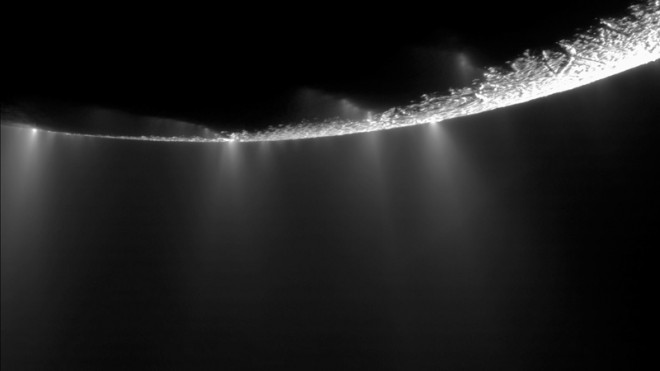Hidden ocean on Saturn’s moon bolsters life theory

This photo provided by NASA shows water vapor jets, emitted from the southern polar region of Saturn’s moon Enceladus. Scientists have uncovered a vast ocean beneath the icy surface of the moon, they announced Thursday, April 3, 2014. Italian and American researchers made the discovery using Cassini, a NASA-European spacecraft still exploring Saturn and its rings 17 years after its launch from Cape Canaveral. (AP Photo/NASA, JPL, Caltec, Space Science Institute)
WASHINGTON – Saturn’s moon Enceladus is home to an ocean of melted water beneath its surface, and could be a source for alien microbes, scientists said Thursday.
The first measurements of the subsurface water at the south pole of the small and icy moon were made by the US space agency’s Cassini spacecraft, and are described in the journal Science.
The body of water is about the size of Lake Superior, the second largest lake on Earth, and has a rocky bottom which could create conditions that allow tiny life forms to thrive.
Researchers first raised the possibility of a below-ground ocean on Enceladus in 2005, after water vapor was detected spewing from vents near the moon’s southern pole.
“Material from Enceladus’ south polar jets contains salty water and organic molecules, the basic chemical ingredients for life,” said Linda Spilker, Cassini project scientist at NASA.
Article continues after this advertisement“Their discovery expanded our view of the ‘habitable zone’ within our solar system and in planetary systems of other stars,” she added.
Article continues after this advertisement“This new validation that an ocean of water underlies the jets furthers understanding about this intriguing environment.”
The Cassini spacecraft detected the shape of Enceladus’ gravity field during three flybys from 2010 to 2012.
The gravitational tug exerted on the unmanned orbiter was carefully analyzed for clues about what the interior of Enceladus contained.
Researchers believe the 500-kilometer (310-mile) wide moon’s ocean is encased beneath a thick crust of crystal ice.
“For the first time, we have used a geophysical method to determine the internal structure of Enceladus,” said co-author David Stevenson, professor of planetary science at Caltech.
“This then provides one possible story to explain why water is gushing out of these fractures we see at the south pole.”
The Cassini mission is led by NASA, with the cooperation of the Italian Space Agency and European Space Agency.
The spacecraft was launched 2004 and has visited all of Saturn’s largest moons.
The sixth planet from the Sun, Saturn is characterized by its unusual rings and has 53 known moons and nine provisional moons.